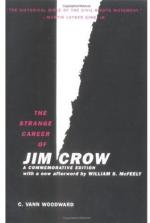
|
| Name: _________________________ | Period: ___________________ |
This test consists of 15 multiple choice questions and 5 short answer questions.
Multiple Choice Questions
1. Which of the following is not on the list of phenomena that began to appear in the late 1800s?
(a) Exploitation.
(b) Cruelty.
(c) Ambivalence.
(d) Brutality.
2. Who is the author of "Prosperity of the South Dependent Upon the Elevation of the Negro?"
(a) Blair.
(b) Washington.
(c) Cable.
(d) Stowe.
3. What trait did both the Democrat and Republican parties share at the time?
(a) Work toward desegregation.
(b) Belief in white supremacy.
(c) Uniting North and South.
(d) Fending off foreign enemies.
4. What culture had and has a belief that it is superior to the black culture?
(a) Caucasian.
(b) Anglo-Saxon.
(c) Asian.
(d) European.
5. Which states seemed to have the most tolerance for desegregation?
(a) Coastal.
(b) Inland.
(c) Southern.
(d) Border.
6. The change of laws in the south may be attributed to various actions often referred to as:
(a) Efforts.
(b) Pointless.
(c) Movements.
(d) Causes.
7. What is the word used to describe people who disliked or were afraid of the Negroes?
(a) Collaborators.
(b) Negrophobes.
(c) Negrophiles.
(d) Supremacists.
8. That particular type of philosophy was often referred to as a(n) ______ philosophy.
(a) Purposeless.
(b) Uninformed.
(c) Viable.
(d) Aristocratic.
9. According to the author, only a small percentage of ______ has escaped attack.
(a) Underground railroad.
(b) Northern laws.
(c) Segregation code.
(d) Blacks.
10. What word best describes how the liberals felt about that particular policy?
(a) Ignorant.
(b) Humorous.
(c) Humiliating.
(d) Degrading.
11. What is the name of the principle that ended in an unstable alliance?
(a) Integration.
(b) Calculable.
(c) Indeterminate.
(d) Fusion.
12. What word is best used to describe the pre-war south?
(a) Rural.
(b) Country.
(c) Urban.
(d) Metropolitan.
13. What was a common name often used to disparage whites?
(a) Wasp.
(b) Cracker.
(c) Honky.
(d) Whitebred.
14. What formal document is said to have officially abolished slavery?
(a) Gettysburg Address.
(b) Watergate.
(c) Treaty of Lee and Grant.
(d) Emancipation Proclamation.
15. What is still the most prevalent issue between blacks and other ethnicities in the US?
(a) Slavery.
(b) Labor Union.
(c) Civil War.
(d) Civil rights.
Short Answer Questions
1. The Northerners often ignored what part of their cities?
2. Blacks were allowed to be an integrated part of the crowds on "common carriers." Which of the following is not a common carrier mentioned in the book?
3. What was the term used to define government officials put in charge of the new laws regarding former slaves?
4. In what year did the approval for voting appear?
5. In what year was the book published?
|
This section contains 368 words (approx. 2 pages at 300 words per page) |

|




